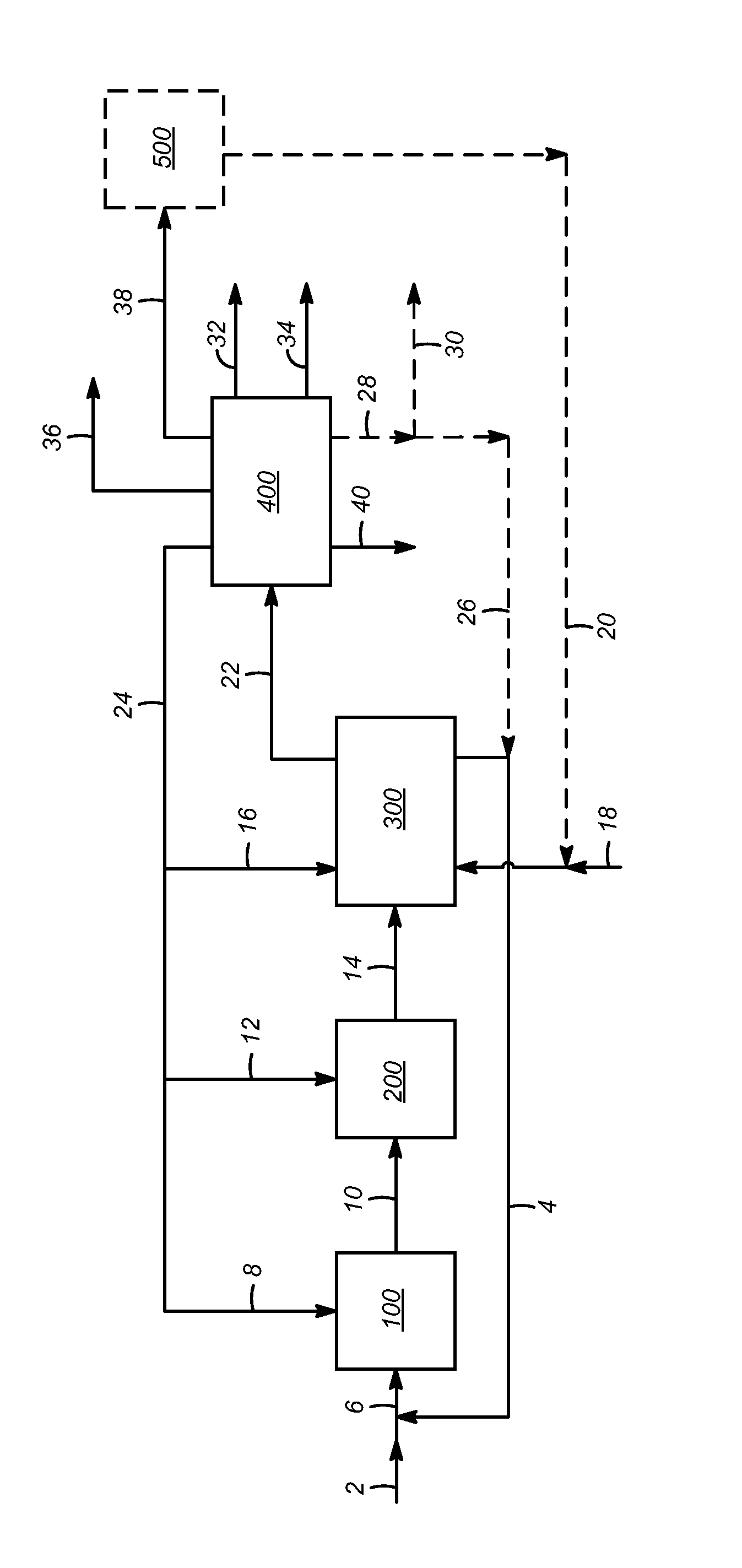[0009]Likewise, the products of
Biomass to Liquid (BTL) pathways described above, which include the products of gasification followed by F-T synthesis, are generally of significantly lower quality, compared to their counterpart, paraffin-rich
petroleum derived products used for fuel blending. This quality deficit results from the presence of oxygenates and possibly olefins, with amounts of these non-paraffin impurities depending on the F-T catalyst and
processing conditions used. In addition, F-T waxes have a wide
carbon number (and consequently molecular weight) distribution and very poor cold flow properties. Both of these characteristics may be improved using hydrocracking, as a specific hydroprocessing reaction, to convert F-T waxes into a paraffin-rich component, with a lower average molecular weight (and narrower molecular
weight distribution) a greater degree of branching (or content of isoparaffins), in order to meet specifications for blending into distillate fuels such as
aviation and
diesel fuel.
[0010]Hydroprocessing of both a
fatty acid- or
triglyceride-containing component and a paraffin-rich component (e.g., derived from
coal,
natural gas, or
biomass) provides simultaneous upgrading of at least these two components, which, following
fractionation of the resulting, hydroprocessed product, can provide a hydroprocessed
biofuel meeting applicable composition and quality standards. In addition, the
oxygenate content of the fatty acid- or triglyceride-containing component, which is generally significantly higher than that of the paraffin-rich component (e.g., derived from F-T synthesis), is diluted during hydroprocessing. This further simplifies the overall process, by reducing adiabatic temperature rise and the corresponding production of undesirable
coke precursors. According to embodiments of the invention, involving co-processing of an “aromatic-rich” component described below, a biofuel that does not require further blending with aromatic hydrocarbons, such as an on-spec diesel biofuel, is obtained after hydroprocessing and
fractionation.
[0011]Embodiments of the invention therefore relate to novel production methods for fuel compositions that are at least partially, but often completely, derived from renewable carbon sources. These sources include a fatty acid- or triglyceride-containing component and a paraffin-rich component that may likewise be derived from renewable carbon (e.g., from the BTL pathway, combining gasification of biomass and F-T synthesis, as described above). Representative methods comprise contacting these components with hydrogen together in a common hydroprocessing reactor to achieve efficiencies and other advantages, as discussed herein, compared to separately upgrading these components. Following
fractionation of the hydroprocessed product, the resulting hydroprocessed biofuel (e.g., a hydroprocessed diesel biofuel, having a significant quantity of paraffinic and iso-paraffinic hydrocarbons) may be used in neat form (e.g., as a
diesel fuel) or otherwise blended, for example, with conventional petroleum derived blending stocks. Whether or not the hydroprocessed biofuel is blended, the
carbon footprint of the resulting neat biofuel or blended biofuel can be reduced.
[0012]Other embodiments of the invention relate to production methods for hydroprocessed biofuel exhibiting a GHG emission, based on LCA, which is further reduced by virtue of using a renewable carbon-derived source of hydrogen for the hydroprocessing step. In particular, byproducts (e.g.,
light hydrocarbons) of hydroprocessing and / or F-T synthesis can be converted, according to an overall hydroprocessed biofuel production process, in an integrated hydrogen generation unit. For example, a catalytic steam reformer may be integrated with one or both of a catalytic hydroprocessing unit and a F-T synthesis unit. Therefore, at least a portion of the byproducts of any one or more of these operations may be converted to hydrogen (e.g., by catalytic
steam reforming), thereby generating at least a portion of the hydrogen required for hydroprocessing. Importantly, the generation of hydrogen in this manner (i.e., from byproducts obtained from the processing of feedstocks comprising renewable carbon) beneficially reduces the amount of hydrogen that must be obtained from external fossil sources (imported), thereby further lowering the lifecycle GHG emission value of the resulting hydroprocessed biofuel. According to other embodiments in which gasification and F-T synthesis are used to provide the paraffin-rich component, a portion of the
syngas from gasification can be purified and used as a renewable source of hydrogen for hydroprocessing.
 Login to View More
Login to View More  Login to View More
Login to View More 
